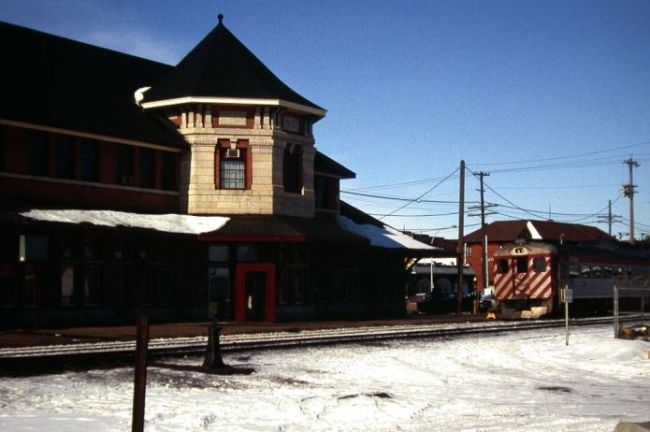
| WWT Shows | CLICK TO: Join and Support Internet Horology Club 185™ | IHC185™ Forums |

|
• Check Out Our... • • TWO Book Offer! • |
Welcome Aboard IHC185™  Internet Horology Club 185
Internet Horology Club 185  IHC185™ Discussion Site Main Page
IHC185™ Discussion Site Main Page  Our Exclusive "Timekeepers Photo Gallery"
Our Exclusive "Timekeepers Photo Gallery"  IHC185™ "Timekeepers Photo Gallery"
IHC185™ "Timekeepers Photo Gallery"  A jewel in the rough
A jewel in the rough
 Internet Horology Club 185
Internet Horology Club 185  IHC185™ Discussion Site Main Page
IHC185™ Discussion Site Main Page  Our Exclusive "Timekeepers Photo Gallery"
Our Exclusive "Timekeepers Photo Gallery"  IHC185™ "Timekeepers Photo Gallery"
IHC185™ "Timekeepers Photo Gallery"  A jewel in the rough
A jewel in the roughGo  | New Topic  | Find-Or-Search  | Notify  | Tools  | Reply to Post  |  |
| Railway Historian IHC Life Member Site Moderator |
On this trip I gave my older sister Helen a call she lived close by in the district of Bonnie Dune, she invited me over to spend the night with her and the family. When it was time to leave on Sunday afternoon my brother-in-law Ron drove me over to the depot and it gave me a chance to show him and my young niece René the Dayliner. Ron took this photo of me at the controls. I have my right hand on the air brake handle, and I wearing my Brotherhood of Locomotive Engineers, baseball cap.  | |||
| Railway Historian IHC Life Member Site Moderator |
We let my young niece René sit in the locomotive engineers seat, and took this photo. It gives a better view of the controls on the left-hand side you can see the handset and cord for the railway radio, the aluminum housing below the card is where the reverser lever, and the four-speed throttle handle goes. to the right of the brake handle are the two gauges for the air brake system. Running southbound from South Edmonton, I would run 96.9 miles on the Leduc Subdivision, this was train order timetable authority, with operators at Wetaskiwan Mile 57.9 and Lacombe Mile 18.7. It also had an ABS signal system (ABS stands for Automatic Block System.) an added safety control that would warn train crews of another opposing train in the block, or of a roken rail or open main track switch. Arriving at Red Deer, Alberta. There was a station stop, departing Red Deer, we were now running on the Red Deer Subdivision, a distance of 93.6 miles to Calgary, this subdivision was run on timetable, train order authority, but did not have any signal system, so it was called dark territory, there were operators at Didsbury Mile 46.4 and Crossfield Mile 28.9 The Dayliners were running in 1983, when there was a tragic accident, at that time on March 23, a track maintenance had a work authority from a storage spur and sulfur tank car loading racks at Wessex Mile 34.6 they had a track authority to go out and spread track maintenance, materials, along the right away North of Wessex, they had a self propelled unloading crane and a couple of cars of track materials, with this authority the track maintenance foreman had his crew opened the Wessex main track switch and instructed his men to leave the track switch in the open position, thinking that he would come back there to clear the southbound passenger train, he was able to spread more materials, then he had anticipated and decided to clear the passenger train at the Home Oil spur, the southbound passenger train called up the maintenance of way foreman to get permission to travel through his works limits that were on their train orders, he radioed them that he was in the clear at the Home Oil spur, his men were at the trackside to inspect the southbound passenger train, and the track maintenance foreman instructed use crew men to open up the main track switch so they could continue their work. It was then that he realized in horror that the main track switch at Wessex was left open, the passenger train was going 60 miles an hour when it hit the open main track switch and plowed into the sulfur tank cars spotted in the spur. The locomotive engineer was crushed to death, and three passengers lost their lives, the days of the Dayliner's were numbered in 1985. There was another bad accident at Penhold when the afternoon. Northbound passenger train ran into loaded gravel truck, the engineer, who I knew well, as he was one of the first engineers are trained with on the Brooks subdivision in January 1979, I was working an afternoon yard engine in the Industrial Yard, and Walter waved to the as he went by northbound, when we stopped for coffee break. I heard the bad news that he had perished in the collision. It was soon after that VIA Rail made a decision to discontinue the service. more tomorrow 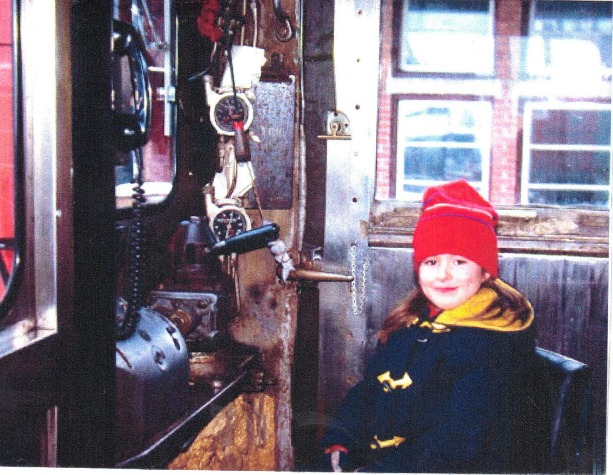 | |||
| Railway Historian IHC Life Member Site Moderator |
In 1966, New York Central railway took a RDC, 3 combine baggage, and coach No. M-497 added a shovel nose for better aerodynamics and mounted on the roof two General Electric J 47-19 jet engines off of a retired Convair Intercontinental bomber. The modifications were done at the NYC's shops in Collinwood, Ohio. On the test day in July, they found a stretch of tangent track and a speed of 297 mph was reached, on a mixture of jointed rail, and continuous welded rail. The experiment was a success; the only drawback is that they could only go in one direction. Where with the conventional RDC's had locomotive engineers controls on both ends, and the ability to backup if you overshot the station platform. 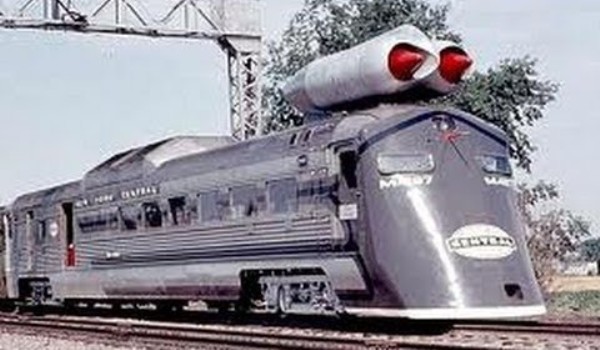 | |||
| Railway Historian IHC Life Member Site Moderator |
An action shot of the test trial on July 23, 1966, they most of the patrol cars at every level crossing along the route to make sure no vehicles got in the way, now that's what I call a BALLAST SCORCHER. New York Central were once again making speed records like they did in the 1893 run of NYC 999 on the Empire State Express, with Charlie Hogan at the throttle, where speeds of 112 mph were recorded. 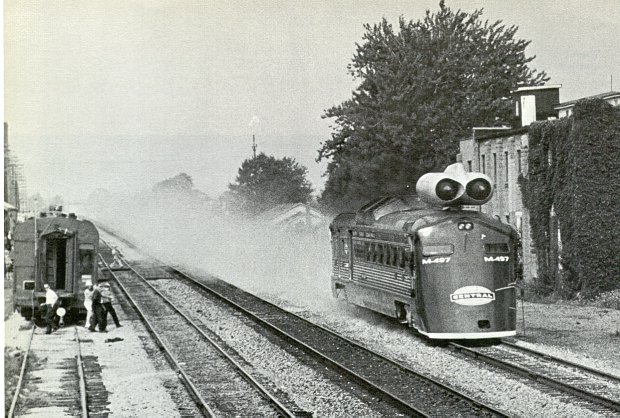 | |||
| Railway Historian IHC Life Member Site Moderator |
Above the bell are four charters, the one on the left is for Sunalta Division No. 469 of the Grand International Auxiliary to the Brotherhood of Locomotive Engineers Chartered in Alberta on August 26, 1909. The Grand International Auxiliary to the B of LE was started by Mrs. Murdoch, the wife of a locomotive engineer in Chicago in 1888, they were the home front of the locomotive engineers, and helpmates, GIA divisions sprouted up in B of LE divisions all over the United States and Canada, they remained active right up into the 2000's although the membership had diminished and it has become a part of history, and as they say, those who are first will be last. Other Brotherhoods and Orders followed the locomotive firemen's wives formed a Ladies Society, and the Order of Railway Conductors, and the Brotherhood of Railroad Trainmen formed Ladies Auxiliaries, when firemen, conductors, and trainmen merged to form the United Transportation Union in 1969, the ladies organization were deemed archaic and obsolete and disbanded. I've attached a clever invitation in the form of a CPR train order to attend the B of LE Division 355 fifth annual ball in 1914. 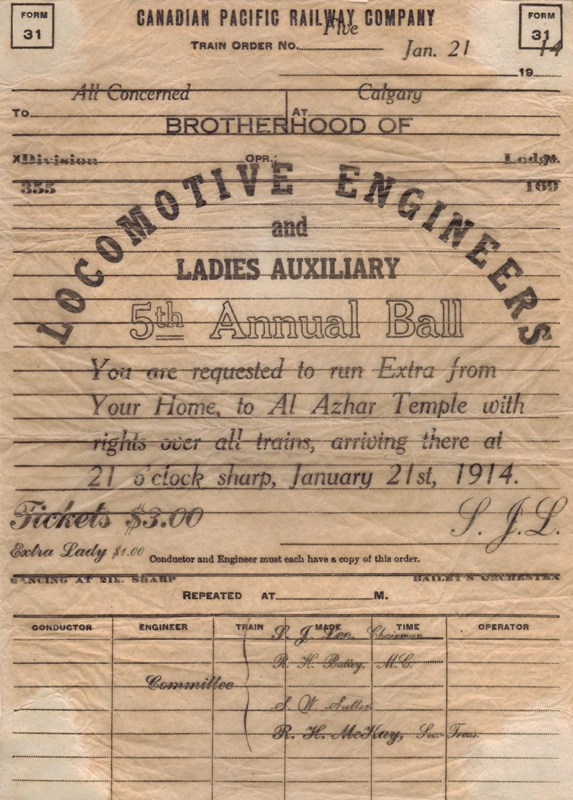 | |||
| Railway Historian IHC Life Member Site Moderator |
A GIA to the B of LE, 14 K ladies pin 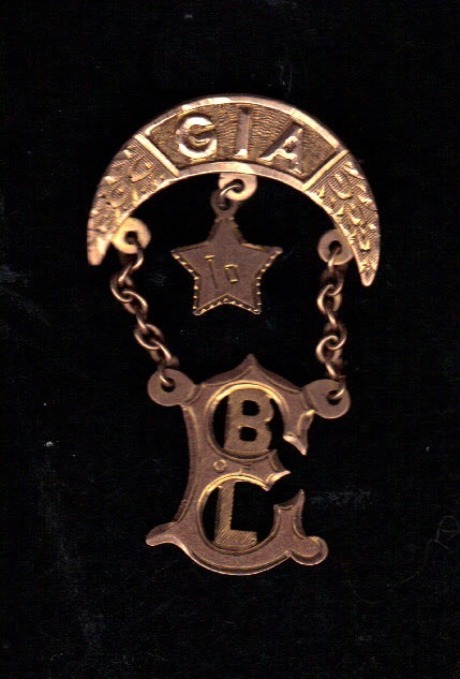 | |||
| Railway Historian IHC Life Member Site Moderator |
A GIA ladies membership pin 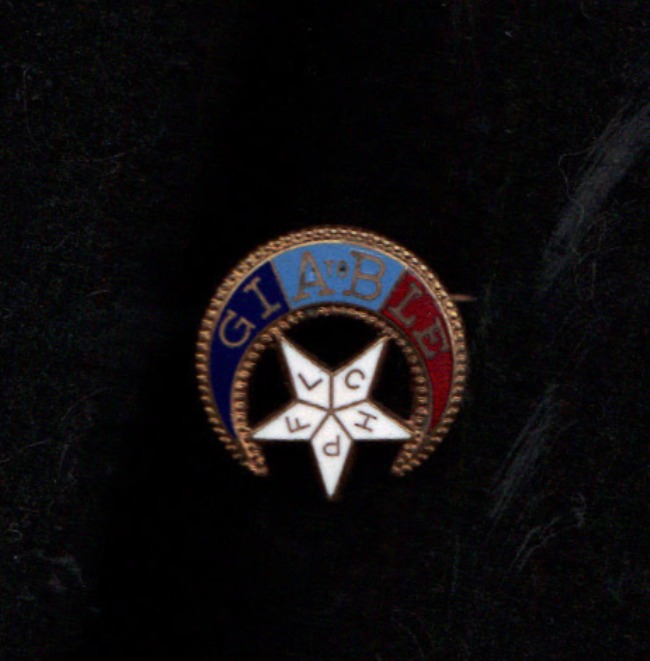 | |||
| Railway Historian IHC Life Member Site Moderator |
A photo of Sunalta Division 469 of Grand International Auxiliary taken in front of Calgary, Alberta's sandstone City Hall, that was built in 1911 the ladies are standing on the front steps, the man in the back row under the arch is the City of Calgary Mayor Andrew Davidson, he served from 1930 to 1945, so I would date this photo in the early 1930s. My grandfather, Frederick, immigrated from Scotland to Calgary in 1911, and got a job as a city Hall clerk, he rose up in the ranks and by 1924, was the Assistant City Treasurer, soon after he became the City Treasury Department serving under Mayor Davidson from 1930 until 1940, when he passed away. 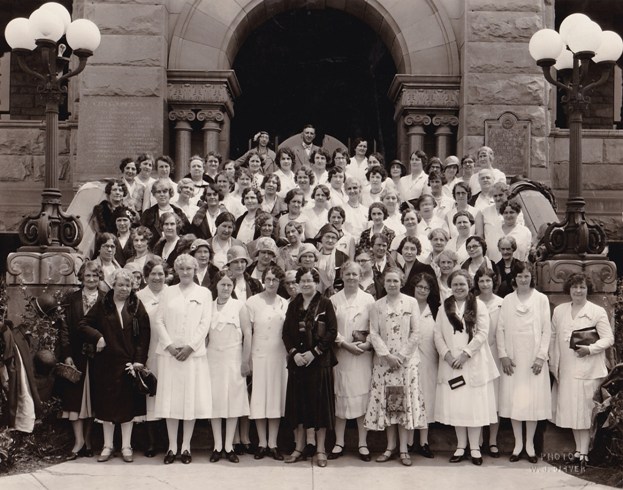 | |||
| Railway Historian IHC Life Member Site Moderator |
Next Is a Charter from Division 355 of the Brotherhood of Locomotive Engineers chartered on January 16, 1903 in Calgary North West Territories sealed and signed by the International President Peter M. Arthur he was born in Scotland, in 1831 and emigrated to New York State when he was 11 where he worked on his uncle's farm near Schenectady, in 1849, got a job as an engine wiper on a New York Central railroad line and soon thereafter became a locomotive engineer, in 1963, he was a charter member of the Brotherhood of Locomotive Engineers, and he pulled the Lincoln funeral train from Albany westward on his journey from Washington, DC to Springfield, Illinois. In 1874 he was elected as the Grand Chief Engineer of the B of LE and held this office until his death. Under his stewardship, the organization changed from a largely benevolent and insurance society to an economic-oriented trade union. He was a conservative trade unionist, and seldom called for strikes, preferring to resolve disputes through conciliation and arbitration. Allan Pinkerton, another Scotsman born in 1819 and head of the Pinkerton Private Detective agency wrote about the B of LE and Peter M Arthur in his 1878 book, Strikers, Communists, Tramps and Detectives, he dedicated a whole chapter to the B of LE and Peter M Arthur that was libelous in nature in my view of it. 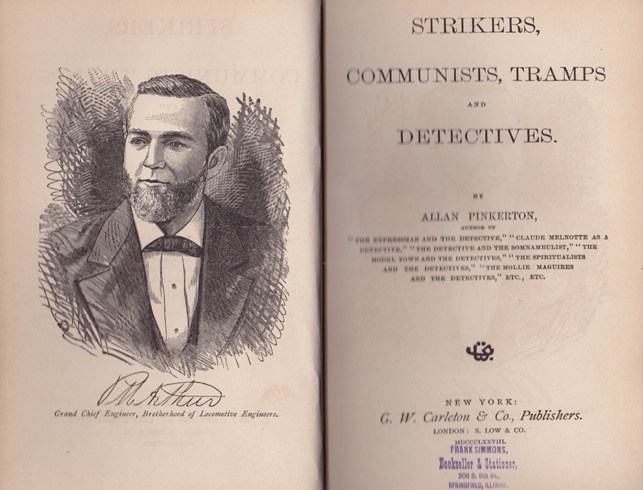 | |||
| Railway Historian IHC Life Member Site Moderator |
A great meeting of Canadian members of the Brotherhood had been called at Winnipeg, Manitoba in July, 1903; and the Grand Chief had promised to attend. On the night of July 16, a banquet was spread. The Grand Chief was toasted and he was presented with a beautiful floral and made of immortelles. Lengthwise of the boiler where the letters "B. of L.E." The engine cab was green. The headlight was represented by a portrait of Ash Kennedy, a prominent Canadian locomotive engineer that held high office in Cleveland. The Grand Chief rose to respond to a toast and said: "Out of the fullness of the heart the mouth speaketh. This, to my mind, is a fitting close to three days of unalloyed pleasure bestowed on me and my associates in the city of Winnipeg. As I look over this audience, it is a scene that inspires my heart with gratitude to the Giver of all good, that I have been permitted to look upon your face upon this happy occasion. It is a scene that ought to inspire the hearts of every member of our Brotherhood, because if we had no Brotherhood you would not be here tonight. Let me impress this fact upon every member, that the fact of your having a Brotherhood in Winnipeg has enabled you to gather tonight and dine together. I want to say a few things, as it may be my parting words too many of you -" The banquet chamber were all enthusiasm, when suddenly the Grand Chief paused. He placed his hands on the table in front of and in low tones, said, "We are here tonight. No one can tell." And with those words he dropped toward his chair, falling into the arms of W.B. Prenter and Ash Kennedy. He never roused from the deep sleep which enveloped him. It was a grave loss to the Brotherhood; and the mournful scene followed when his body was brought back to Cleveland, Ohio. There on July 20, attended by his family, the Grand Officers and members of the organization and by prominent representatives from labor organizations - he was buried. His coffin was lowered into the earth with the well-known words, "Dust to dust, ashes to ashes," and the curtain was drawn on one of the most dramatic lives which has appeared in the annuals of labor. 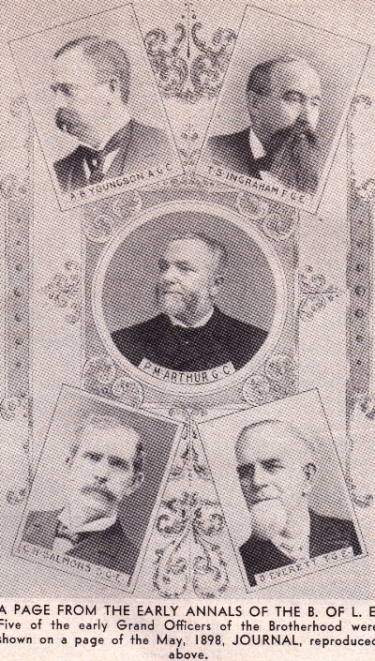 | |||
| Railway Historian IHC Life Member Site Moderator |
Next are two charters from the Brotherhood of Locomotive Firemen, the first from Bangor, Maine for Penebscot Lodge 514 chartered January 28, 1894, that represented locomotive firemen on the Maine Central Railroad. The second charter is from the same Lodge, but was reissued on March 1, 1909 when the trade union changed its name from the Brotherhood of Locomotive Firemen to the Brotherhood of Locomotive Firemen and Enginemen. I also have a colored lithograph chart from the Brotherhood of Locomotive Firemen, this one is marked "Presented from Grand Lodge to Penebscot Lodge 514" and would have been on display in their meeting hall. 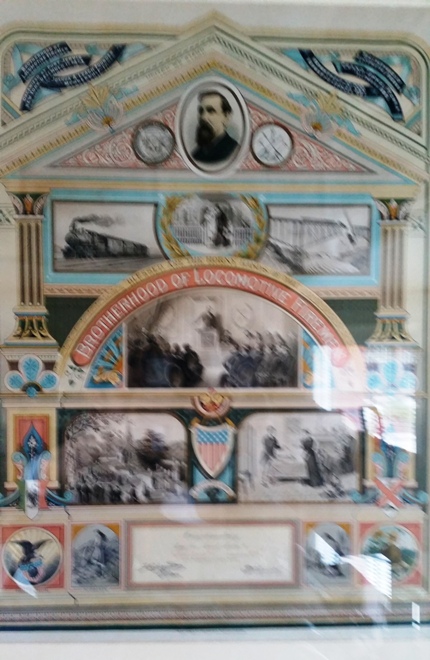 | |||
| Railway Historian IHC Life Member Site Moderator |
Here is a advertisement from a 1895 Brotherhood of Locomotive Firemen's Magazine for "The Brotherhood Chart" this chart was designed by Samuel Stevens The Grand Organizer for the Brotherhood of Locomotive Firemen, the advertisement says; "The above is a photo engraving of the elegant new Membership Chart sold by the Grand Lodge, B of LF for seventy-five cents each. Splendid commissions are offered to agents who should correspond with F.W. Arnold, G.S. & T., Peoria, Illinois." The scenes on these colorful charts were a big part of the initiation ceremonies for new members joining the B of LF. 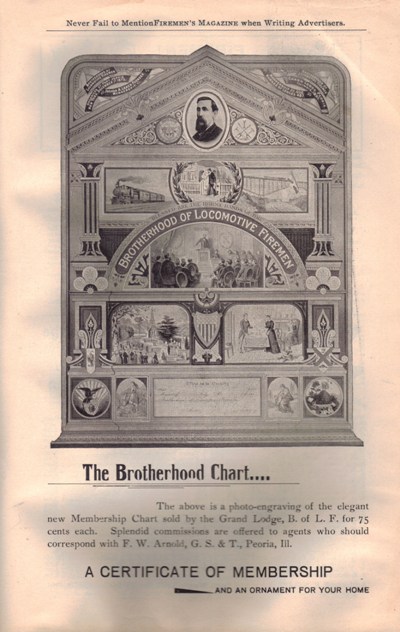 | |||
| Railway Historian IHC Life Member Site Moderator |
I am fortunate to have in my collection, a complete set of wooden framed hand-painted color glass slides, the 14 slides were made by the M.C. Lilly Co. of Columbus, Ohio the slides illustrate views shown on the Brotherhood Chart here is the list: No. 1 Home. No. 2 Round House. No. 3 On the Road. No. 4 The Wreck. No. 5 Funeral. No. 6 Payment of Beneficiary Certificate No. 7 Faith, Hope, Charity. No. 8 Grand Lodge No. 9 Protection. No. 10 Charity. No. 11 Sobriety. No. 12 Industry. No. 13 Coat of Arms No. 14. Joshua Leach (B of LF Founder from Port Jervis, N.Y.) 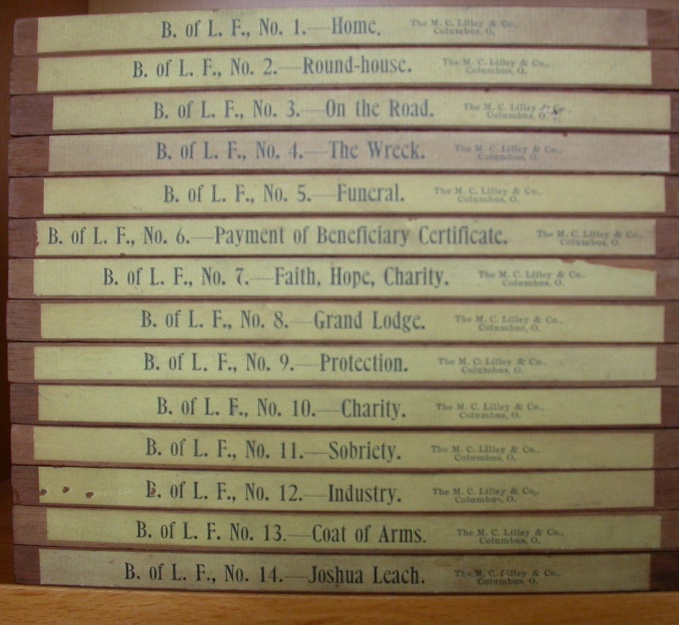 | |||
| Railway Historian IHC Life Member Site Moderator |
This view shows glass Slide No. 1 Home, it shows the Locomotive Firemen in front of his home, saying goodbye to his wife and children. 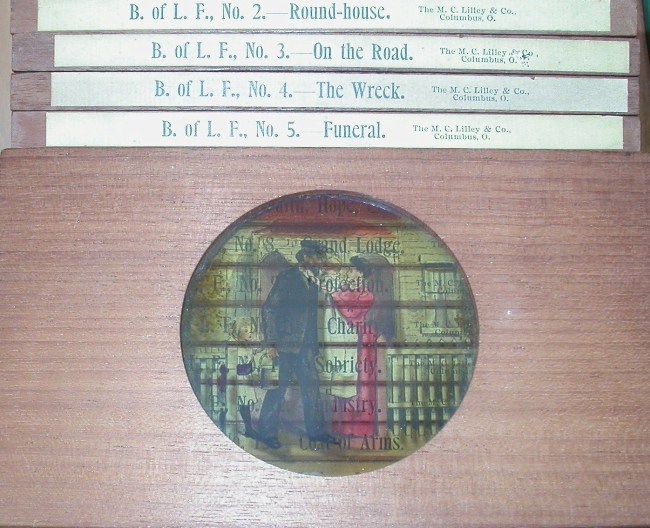 | |||
| Railway Historian IHC Life Member Site Moderator |
The Brotherhood of Railroad Trainmen had a Brotherhood Chart the same as the Locomotive Firemen. An 1890s advertisement from the Railroad Trainmen's Journal from the M.C. Lilly Co. Columbus, Ohio Regalia and Supplies of Every Description here there advertising "Our New Magic Lantern" it goes on to say "With colored slides for illustrating the chart is essential to the success of every lodge." In the late 1800s before they had the luxury of electricity, these Magic Lanterns used kerosene to illuminate the projector, most Lodge meetings were held in the evenings so they hall could be darkened, and white sheet could be pinned to the wall and slides could be projected. With the slides at the lecture from the ritual. It would be a very memorable occasion for the new candidates for membership in the B of LF. 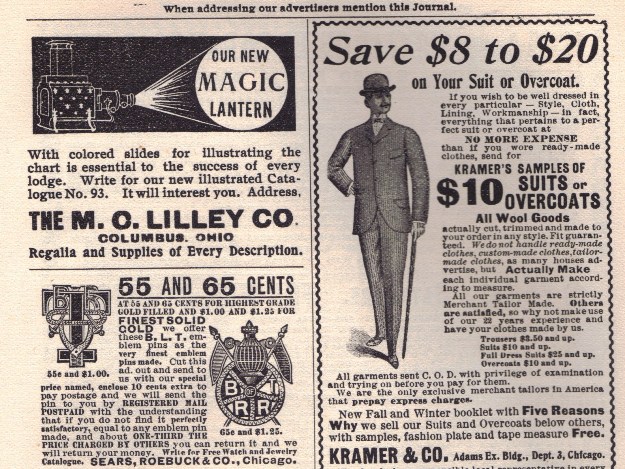 | |||
| Railway Historian IHC Life Member Site Moderator |
Here is another advertisement from an 1890s Railroad Trainmen's Journal from the M.C. Lilly Co. Columbus, Ohio for their Regalia colored reversible Parade and Funeral Ribbons, Magic Lanterns and Colored Slides 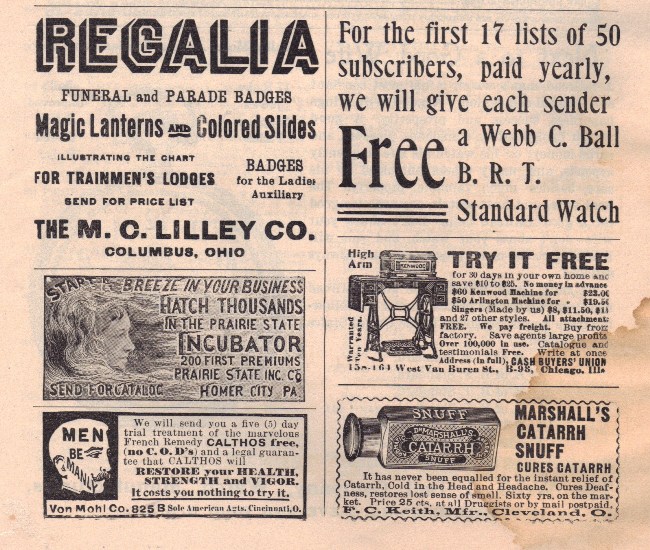 | |||
| Railway Historian IHC Life Member Site Moderator |
The next charter is from the Brotherhood of Railroad Trainmen, it was issued on September 1, 1886 to Pioneer Lodge No. 238, at West Springfield, Massachusetts that represented trainmen on the Boston and Albany Railroad and represented trainmen on the road and yards. It is signed by the Grand Master Stephen E. Wilkinson, and the Grand Secretary Treasurer Ed F. O' Shea Another interesting Brotherhood of Railroad Trainmen, artifact in my railway museum; John M. Cunningham's B of RT membership certificate, beautifully hand inked calligraphy, with his portrait. He was initiated to C. A. Yoh Lodge, 736, originally in Chambersburg, Pa. Moved 24 miles South to Hagerstown, Maryland chartered September 24, 1905, representing trainmen, yardmen on the Pennsylvania Co. (East), he retired in October 1, 1953 with 45 years 11 months service from September 1, 1907. 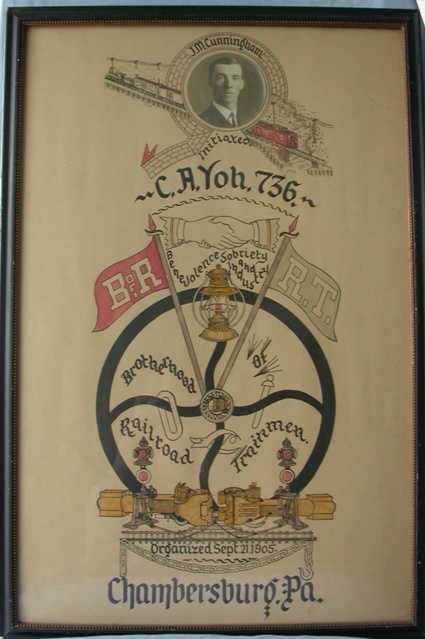 | |||
| Railway Historian IHC Life Member Site Moderator |
We now get into the three glass cabinets underneath the charters, the first one to the left holds my collection of Brotherhood of Locomotive Engineers Convention Medals and Ribbons from 1898 to 2001 My earliest B of LE Convention Ribbon is from the 3rd Biennial Convention held in St. Louis, Mo in 1898, it also says Complements of The International Correspondence Schools of Scranton, Pennsylvania.  | |||
| Railway Historian IHC Life Member Site Moderator |
he first two pewter ones on the left were made by the Webb C Ball Co. of Cleveland, Ohio. The upper one is from Wayne Division No. 741 and was located in Orrville, Ohio, and represented locomotive engineers on the Pennsylvania System (Lines West) Cleveland Division. The one below Is missing its Division No. To the right are all two convention medals from the 4th Biennial Convention held in Milwaukee, Wisconsin in 1900 on top would be a badger. I guess Wisconsin being the badger state, although it looks more like a beaver to me. On the circular medallion is a portrait of P.M. Arthur. Another pewter badge made by the Webb C Ball Co., Cleveland, Ohio. This one is a Honorary badge given out to members with 40 years service, I have many of these mostly gilt ones. The Locomotive 554, a 10 Wheeler made some speed records itself, before the NYC 999 did its record run in 1893. The next celluloid button commemorates an excursion made on March 20, 1901 by the B of LE members of the New York Central System on the Empire State Express to the Pacific Coast, I have a pamphlet that describes this trip. They changed trains at Chicago and went to California from there.  | |||
| Railway Historian IHC Life Member Site Moderator |
he first two pewter ones on the left were made by the Webb C Ball Co. of Cleveland, Ohio. The upper one is from Wayne Division No. 741 and was located in Orrville, Ohio, and represented locomotive engineers on the Pennsylvania System (Lines West) Cleveland Division. The one below Is missing its Division No. To the right are all two convention medals from the 4th Biennial Convention held in Milwaukee, Wisconsin in 1900 on top would be a badger. I guess Wisconsin being the badger state, although it looks more like a beaver to me. On the circular medallion is a portrait of P.M. Arthur. 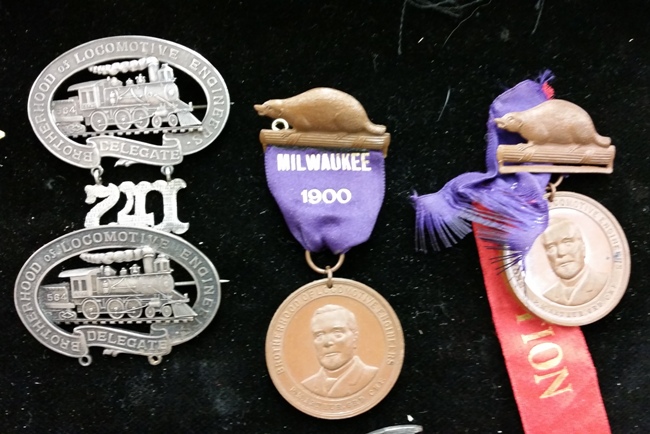 | |||
| Railway Historian IHC Life Member Site Moderator |
Here is a advertisement from a 1895 Brotherhood of Locomotive Firemen's Magazine for "The Brotherhood Chart" this chart was designed by Samuel Stevens The Grand Organizer for the Brotherhood of Locomotive Firemen, the advertisement says; "The above is a photo engraving of the elegant new Membership Chart sold by the Grand Lodge, B of LF for seventy-five cents each. Splendid commissions are offered to agents who should correspond with F.W. Arnold, G.S. & T., Peoria, Illinois." The scenes on these colorful charts were a big part of the initiation ceremonies for new members joining the B of LF. 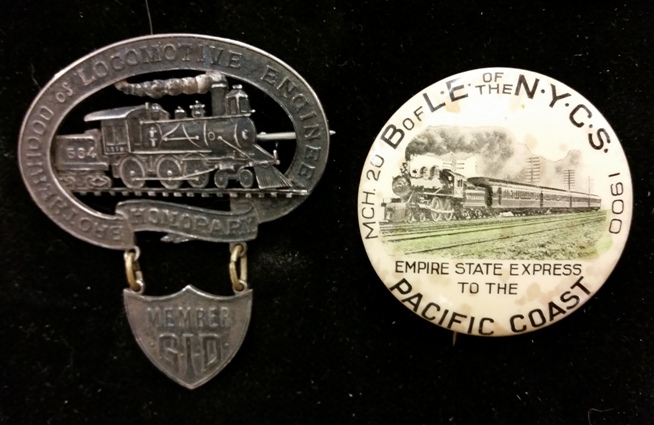 | |||
| Powered by Social Strata | Page 1 2 3 4 |
| Your request is being processed... |
|
©2002-2025 Internet Horology Club 185™ - Lindell V. Riddle President - All Rights Reserved Worldwide


